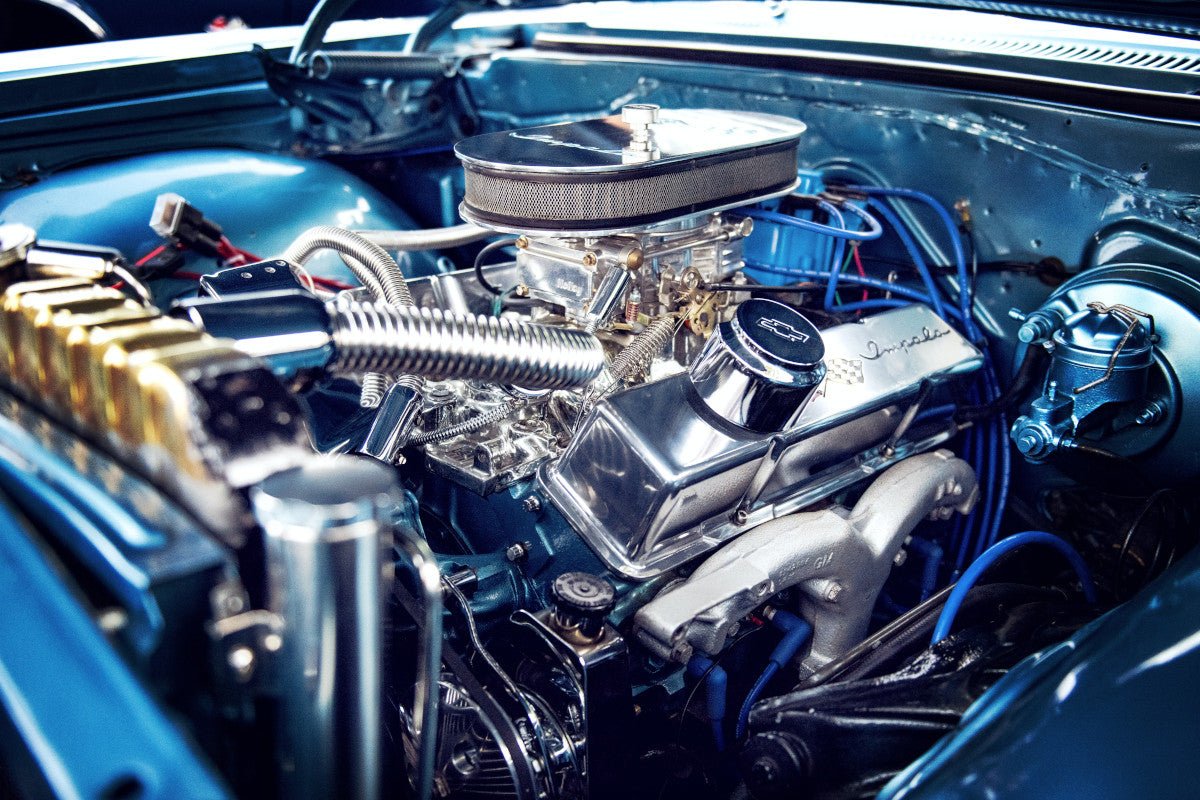4.6 Rating | 95% Recommend ⭐️⭐️⭐️⭐️⭐️

What Causes a Serpentine Belt to Break?
Picture this: you’re cruising down the road or adventuring off the beaten path when you’re startled by a high-pitched squealing noise. Or, maybe you notice your car’s power steering is dampened. Perhaps your gauge warns you of an overheating engine.
These are just a few of the telltale signs your serpentine belt is going bad - and there are countless others that can be uncovered through visual inspection of the serpentine system. This is obviously a cause for concern, as the serpentine belt plays such a crucial role in transferring power from the engine to the rest of your vehicle’s systems.
The good news? If you’re worried about your serpentine breaking - or you’re already dealing with this hassle - you’re in the right place. Below, we’ll fully explain what causes a serpentine belt to break.
This will help you prevent future issues - because a lot of the time, a broken serpentine belt is in one way or another the fault of the person who has installed it. From misalignment to over-tensioning, improper installation can be the demise of your system.
Other times, though, it’s merely a result of old age & normal wear and tear. By the time you finish reading this article, you’ll be aware of all the potential causes of a broken serpentine belt. But perhaps more importantly, you’ll gain a few tips for easy, affordable serpentine belt replacement so you can get back on the road fast without breaking the bank. Let’s get started with a quick overview of the role your serpentine belt plays in the first place.
A Brief Overview of the Role Your Serpentine Belt Plays
The serpentine belt, also known as the drive belt or accessory belt, is an important component of a car's engine. Its primary role is to transfer power from the engine to various other systems and accessories in the car, such as the alternator, power steering pump, water pump, air conditioning compressor, and more.
The serpentine belt is typically made of reinforced rubber, and it winds around a series of pulleys that are attached to the various systems it powers. When the engine is running, the serpentine belt rotates these pulleys, which in turn drive the accessories and systems they are connected to.
Because the serpentine belt is responsible for transferring power to critical systems in the car, it plays a crucial role in the performance and operation of the vehicle. If the belt fails or breaks, it can cause significant damage to the engine and leave you stranded on the side of the road.
Keeping the serpentine belt in good condition is therefore essential to maintaining optimal car performance. A worn or damaged belt can cause the accessories it powers to operate inefficiently, which can lead to issues such as decreased power output, poor fuel economy, and overheating.
You can regularly check the belt for signs of wear or damage, ensure proper tensioning of the belt, and replace the belt as recommended by the manufacturer. But - none of this helps you if you’re already dealing with a broken or otherwise damaged belt. So, what causes a serpentine belt to break - how did you get here in the first place? Let’s take a look at all the likely culprits below.
What Causes a Serpentine Belt to Break?
We’re going to cover the 8 most causes of a broken serpentine belt below. Many of these are outside of your control and are to be expected when you own a vehicle and drive it into the ground - but others can be prevented by proper installation, routine maintenance, and better belt selection. Let’s start with one that you can’t control, but should be aware of nonetheless:
Normal Wear and Tear
The most common cause of a broken serpentine belt is simply wear and tear over time. The belt is designed to last for a certain number of miles or years, depending on the vehicle's make and model. Eventually, the rubber material of the belt will start to crack, fray, or break due to exposure to heat, friction, and other factors. After all, this belt takes quite a beating!
The best way to determine if this is the cause of your broken serpentine belt is to verify how old the belt is. When was it installed and how many miles has it been put through? While estimations obviously vary from manufacturer to manufacturer (and driving style), you can expect to get anywhere from 50,000 to 100,000 miles, or around 5 to 7 years of use from a serpentine belt.
Over-Tensioning
Another cause of a broken serpentine belt is over-tensioning, which means the belt is too tight and puts too much strain on the system. Over-tensioning can cause the belt to stretch, warp, or break prematurely, while also damaging the pulleys and other components around the system.
You can routinely check your belt to assess the tensioning and prevent this from happening in the future. You’ll need a tension gauge for this. Or if you have experience working on cars and know what proper tensioning should look/feel like, you can push down on the belt with your finger to see if anything is amiss. If so, you can loosen the belt a bit to save a headache down the road.
Misalignment
If the serpentine belt is not properly aligned with the pulleys, it can cause uneven wear, fraying, or breakage. Essentially, the load isn’t evenly distributed across the belt - and one area takes on more stress than it’s supposed to.
Misalignment can occur due to worn or damaged pulleys, incorrect installation, or other factors like normal wear and tear. Whatever causes it, misalignment poses a risk to your serpentine system and must be checked for on a routine basis - especially as your belt ages, and especially if you installed it yourself without professional guidance. Check for uneven wearing on the belt, as this is a telltale sign of misalignment.
Contamination
When your serpentine belt is exposed to contaminants like oil, coolant, dirt, or other substances, the belt doesn’t just lose performance - it wears faster. Issues like slipping or rubbing can result from contamination, and these are easily avoided by simply cleaning your belt on a regular basis. You can prevent these even further by maintaining a clean engine bay and addressing leaks with urgency.
Improper Installation
Whether you tried to save a few bucks by going to a shoddy shop or doing the work yourself, improper installation leads to suboptimal performance and premature wear/breakage. This can be the result of many different mistakes - from choosing the wrong size or type of belt to routing the belt incorrectly or using improper tensioning.
All of these can be avoided by simply doing the job right the first time around. Take the time to do your research before grabbing a wrench, and don’t rush through the work. When in doubt, leave this task to the professionals. At the very least, you’ll at least be able to fall back on the shop’s warranty if they install the belt wrong!
Damaged Pulleys
Sometimes, a broken serpentine belt is actually the fault of another component in the system: pulleys. Damaged pulleys can cause the belt to become misaligned, leading to increased wear and tear on the belt and other components.
To check for damaged pulleys, visually inspect them for signs of wear or damage, such as cracks or chips in the metal. Also, listen for any unusual noises coming from the engine, such as grinding or squealing, which can indicate a problem with the pulleys.
If you suspect that the pulleys are damaged, it's important to have them inspected and repaired or replaced as needed to prevent further damage to the belt and other components in the engine.
High Engine Load
Most serpentine belts are designed to withstand a certain amount of load and stress. When you operate your vehicle in a manner that puts an excessive load on the system, it can cause the belt to break or become damaged.
High engine load can be caused by factors such as heavy towing, excessive idling, or aggressive driving. Of course, some of these factors are just unavoidable. You want to have fun with your car, so you may just have to deal with a lower lifespan on your serpentine belt system as a result. Just know that heavy acceleration and sudden stops can take a toll quickly.
Is it Common for Serpentine Belts to Break?
Now that you know what causes a serpentine belt to break, is this a common problem vehicle owners face? While you may be stressing over this fix, just know that you’re not alone. As we mentioned earlier, this is something you’ll deal with as soon as 50,000 miles after installation - quicker depending on the belt you bought, the maintenance conducted, and how you drive. Below, we’ll cover a few ways to tell if your serpentine belt is on the brink of breaking.
Signs Your Serpentine Belt is on the Brink of Breaking
Usually, a serpentine belt doesn’t break overnight. You can watch or listen for evidence that a problem is on the horizon - here are a few of the most telltale signs your serpentine belt is broken or breaking:
- Squealing or Squeaking Noises: If you hear a high-pitched squealing or squeaking noise coming from the engine compartment, it may be a sign that the serpentine belt is worn or damaged. This noise can occur when the belt slips or starts to come apart.
- Cracks or Fraying: Inspect the serpentine belt for signs of cracking, fraying, or other damage. Over time, the rubber on the belt can deteriorate and develop cracks or fraying, which can weaken the belt and increase the risk of it breaking.
- Glazing or Smoothness: Check the surface of the belt for any signs of glazing or smoothness. This can occur when the belt starts to slip and wear down the rubber, which can cause the belt to lose its grip on the pulleys and lead to slipping and ultimately breaking.
- Engine Overheating: A failing serpentine belt can cause the engine to overheat. If the water pump is driven by the serpentine belt, a failing belt can cause the water pump to stop working, which can lead to engine overheating.
- Battery Light On: If the battery light on your dashboard comes on or the headlights appear dimmer than usual, it may be a sign that the serpentine belt is not functioning properly. A failing serpentine belt can cause the battery to discharge, leading to a loss of power to the electrical system.
Any of these are signs you should take your car in for a diagnosis. But - what happens if you ignore them and keep driving?
What Happens if Serpentine Belt Breaks While Driving?
My serpentine belt broke while driving…now what? What happens if the serpentine belt breaks while driving? Obviously, you can expect a few problems since this is such a crucial system in your vehicle.
For one, you may lose power steering as this belt sends energy to the power steering pump. You’ll have a harder time turning, which can lead to safety issues. What’s more, the serpentine belt controls your vehicle’s water pump - which means the risk of engine overheating rises when the serpentine belt goes. The other common outcome of a broken serpentine belt is the loss of electrical power. Your alternator will go as a result, which means all sorts of systems will fall out of whack.
All of this is to say that if your serpentine belt breaks while driving, your best bet is to head home or find a shop near you that can get you in ASAP.
Tips for Easy, Affordable Serpentine Belt Replacement
Now - the final thing we want to cover in this conversation on what causes a serpentine belt to break is what you should do next. While the thought of having to pay expensive shop fees or DIY this project can be stressful, it doesn’t have to be. We’re here to help.
At Southwest Performance Parts, we have an unbeatable selection of performance serpentine belt kits. We manufacture and sell these ourselves under our reputable A-Team brand. This means we’re able to cut out the costs of middlemen so you save money while getting the high-quality, dependable auto parts you need.
No matter your make and model, we have a system for you: SBC serpentine belts, SBF serpentine belts, LS serpentine kits, BBC serpentine kits, and BBF serpentine kits. And if you aren’t sure which system is right for you, you can lean on us for a recommendation. We bring 20 years of experience to the table and are passionate about providing you with the advice and components you need to get back on the road and enjoy your car to the fullest.
You can get your new serpentine belt replacement kit today and follow our instructions on installation - or take the new components to a shop you trust to do the work for you. Whatever you do, you’ll be glad you went with Southwest Performance Parts!
Final Thoughts on What Causes a Serpentine Belt to Break
That brings our guide to what causes a serpentine belt to break to a close. At this point, you should feel much more confident in identifying the root cause of a broken serpentine belt. More than that, you should now be able to identify the signs that this problem is coming before it’s too late. We’ve also unveiled the best way to save money while replacing your belt.
So, now that you know what causes a serpentine belt to break, you can head over to our online shop and find your replacement parts today!


